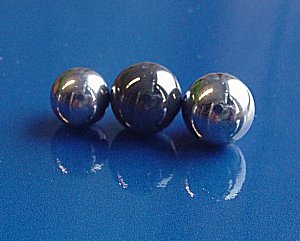| HYBRID BALL BEARINGS | |||
|
For very high running speeds ball bearings are less suitable because of
the additional centrifugal load of the, with cage speed rotating balls.
Balls of small diameter or low density are desirable to limit the
centrifugal load. |
|||

Ball 1: steel D= 8mm m=2.1 gram Ball 2: ceramic Ball 3: steel |
|||
|
ceramic balls The centrifugal load is described by F= -mT2R where m is the weight of the ball. Because the density of silicium nitride is 60% of steel, the centrifugal load is reduced by using these balls with 60%. As a consequence the running speed can be increased up to 30%. Because the E-modulus of silicium nitride is about 1.5 times that from steel, a smaller contact surface exists with the consequence of a high contact pressure. So, the benefit of a small centrifugal load is limited by the large E-modulus. From Hertz theory it follows that the maximum load for the combination steel- silicium nitride reduced with 30%. A decrease of 60% centrifugal loading in combination with a 30% decrease in load capacity finally results in an increase of running speed with only 15%. A third effect, that frictional heating between the ceramic balls and the steel rings is less, further positively affect the maximum running speed. small ball diameter The centrifugal load is with the same cage speed proportional to the ball diameter d3. From Hertz it is known that the maximum load in a point contact is proportional to d2. With both effects considered it follows that with the half ball diameter the running speed may increase with 100%. The fact that the external bearing load is carried by more small contacts is not considered here. Environment Lubrication |
|||
| fys. properties | dim. | Siliciumnitride | 100Cr6 |
|
density thermal expansion E-modulus poisson number Hardness HV10 heat conduction max. temp. |
kg/m3 10E-4 /K GPa - - W/mK °C |
3200 3.2 315...320 0.26 1600 30...35 800...1000 |
7800 11.5 200...210 0.3 700 40...45 150...300 |
| Pot, S., (2001), "Keramische kogellagers (1), a&b, jan/feb. 2001 | |||
| www.tribology-abc.com | |||